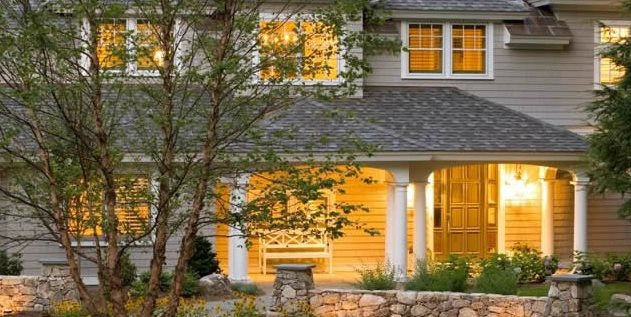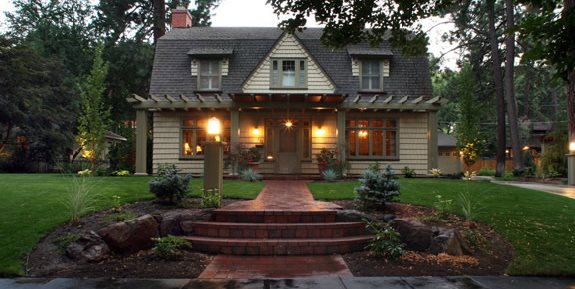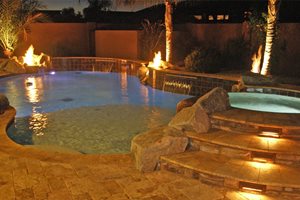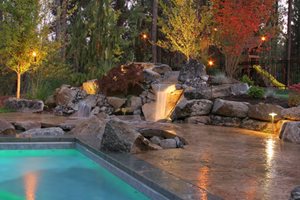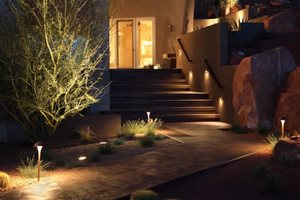How to Install Landscape Lighting
Understanding the installation processWhile at first glance, installing landscape lights may seem straightforward - plug, wire, and go - in fact there are a lot of elements in the process that aren’t intuitive at all. Lighting is usually installed by a professional as part of the overall landscape installation. Here, landscape contractors share the process they use to install outdoor lights.
Installation process
Initial meeting - The process of adding lighting starts with an initial meeting to learn how the landscape will be used. “Do we need downlighting on the grass so the kids can kick the soccer ball around?” asks TJ Wilcoxson of Alexon Design Group in Gilbert, AZ. “Or, some people have putting greens and want to put in the evening after work. The design of the lighting always follows what is happening in the yard and how people will use it,” he says.Written design - A written plan follows that initial meeting. “We do a lighting plan on all of our projects,” says Matt Barton of Coppercreek Landscaping, Inc. in Mead, WA. “We include it as part of the landscape design process.”
Assemble fixtures - “We assemble everything off-site before the job starts,” says Edward Snyder of Greenleaf Services, Inc. in Linville NC. “The fixtures come all boxed up and in parts. There’s the ground stake, the shaft of the light, and the fixture itself, plus all the little wing nuts which hold them together,” he says. “If we were to assemble that at the jobsite, we’d have a truckload of tiny little boxes to haul away.”
Lay out lights - When your landscaper’s ready to go on-site to install the lighting, the first step is to lay them out in the landscape and make sure everyone on the crew is in agreement. “We discuss the goal of each light, the direction it will shine, and the goals of the clients,” says Gerry DuBreuil of Belknap Landscape Company, Inc. in Gilford, NH. This ensures a smooth installation process.
Placement Tips
Landscape Lighting Placement
Get installation suggestions from garden artisan Scott Cohen. Hear about concealing the source of light and see examples of lights incorporated into outdoor bars and seating.
Mount the transformer box - “The transformer is no different than the engine of your car,” says Wilcoxson. The box plugs into a 120-volt outlet and it converts the electricity from the house to a lower current so it can power low-voltage landscape lighting. “Transformers come with all kinds of cool options, too,” says Barton. “Timers, remote controls, photocells to sense light. . . There are even ones that combine a photocell with a timer so you can set it to stay on for 2, 4, or 6 hours after sunset.”
Lay out wiring - Wire for low-voltage lighting comes in a variety of thicknesses, from 8 to 14 gauges. The number of lights used and the wattage of those lights determine the gauge of the wire needed. Copper wire and a marine-grade tin-coated wire are both good choices. When running wires through a bed of annual flowers where people are likely to dig, your landscaper will “sleeve” the wire in a sturdy pipe so it isn’t broken by normal gardening activities.
Scope out runs - It’s important to carefully plan how many lights are run off of each set of wires. While a transformer can control multiple “runs”, each run can only power so many watts. The pros suggest leaving enough room on both the transformer and on each run to allow upgrades, in case you decide to add more fixtures later. “We tend to over-engineer it on the front end so there’s room to expand later,” says Snyder.
Test the system - “We’ll do a voltage read on every light, and make sure all of our connections are good,” says Snyder. “We want to catch any problems before we bury the wiring.”
Aim the lights - Nobody wants their landscape lights blinding them by shining in unintended directions. “We go out at 9PM at the end of every job to adjust the lighting at night so no lights shine into bedrooms or into people’s eyes,” Barton says. “It’s that important to us.” DuBreuil agrees. “We use a laser fixture during the day to anticipate where the lights will shine at night,” he says. “It’s remarkably good at catching problems.”
Bury the wire - In most cases, the wire doesn’t need to be buried very deep. In fact, 2-6 inches will often do. It just needs to be invisible in the finished landscape, and out of the way of tools that might damage it. That said, Snyder points out that some municipalities have regulations about how deep the wire must be buried, so it’s a good idea to check with your city just in case.
- Pro Tip: When converting an existing system from halogen to LED you’ll need a driver to run the LED bulb effectively in a halogen fixture. Converting an old fixture to LED costs only 20% less than buying a brand new fixture, so it’s often best just to use new fixtures.—Matt Barton of Copper Creek Landscaping, Inc. in Mead, WA
Why hire a professional?
There are a lot of considerations involved in installing landscape lighting, including safety, long-term function, and design. Snyder points out, “You could learn to do it yourself and probably save some money, but the time and aggravation involved usually isn’t worth it. There’s a cost to learning, and sometimes it’s better to have it done right the first time.” Barton cautions, “If you put too many lights on a run, the transformer can overheat, catch fire, or even blow up. You always want to buy professional-grade materials and design your system with care.”Another reason to hire a pro is that it gives you some recourse when things go wrong. “If you use someone reputable, someone trusted in the community, you know that when there’s an issue, you’ve got someone to call on,” Snyder says. Your landscaper has a vested interest in keeping their projects looking sharp.
Cost of landscape lighting
The cost of landscape lighting varies wildly by the job. “We design the lighting to suit the landscape, so there’s no magic number or price range that fits all jobs,” says Snyder. There’s always the initial expense of the transformer, which runs from $300-1400, depending on how many lights it can power. You’ll need a transformer no matter what size of job you do. Then, a high-quality LED fixture with a bulb is about $250 for each one. Given this, a minimalist landscape lighting installation with just a few lights could cost as little as $1200-1500.
“We usually spend 10-15% of a project’s budget on the lighting,” says Wilcoxson. “Of course, for larger projects that percentage can come down. On recent projects, our lighting budgets have ranged from $4000-80,000.”
Common mistakes to avoid
- Too much uplighting - Uplighting, or pointing a light upward into a tree or other focal point, “doesn’t exist in nature, which makes it more dramatic,” says Wilcoxson. It’s best used sparingly so as not to visually overwhelm the space.
- Thinking small - “Sometimes I see people who have a beautiful deciduous tree with a nice canopy, and instead of lighting this tree that’s a real feature in the landscape, they’re pointing their lights at the holly in their foundation planting,” says Snyder. Remember to step back and get perspective on what would really make a bold impact.
- Putting the focus on the actual lights - “You don’t want to see the lights themselves, you want to see what they’re lighting,” says Wilcoxson. The unique branch structure, stonework, or architectural feature should be the star of the show, not the lights.
Return to Landscape Lighting

 Backyards
Backyards
 Front Yards
Front Yards

